

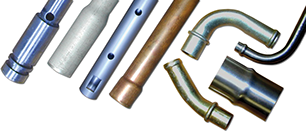
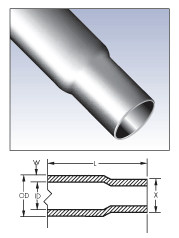
End Reduction - Tube end reducing is a process that reduces the outside diameter (OD) of the tube. Typically this is done so that the reduced end will fit into the inside diameter (ID) of the same tube or fit into some kind of an opening.
There are two different processes that will create a reduce tube end. Ram Forming and Segment, or Finger Segmented Reduction, and Harco offers both versions.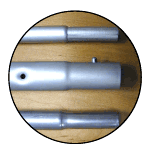
The Ram style of end forming is created by forcing a dedicated die over the end of the tube and then retracting the die back off the tube. The die is designed to achieve the proper OD and length of the reduction and will only create the OD the die is designed for.
Segmented tube end forming involves a series of segmented fingers that close over the OD of the tube and hydraulically reduces the tube size. The benefit of segmented reduction is that you can achieve a reduction within a range, however this style also leaves a series of ribs in the OD of the tube and is not as clean looking as the ram style.
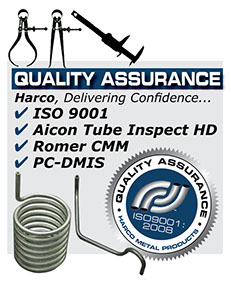
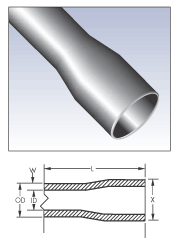
End Expansion - Rotary Arm Tube bending is an accurate, high speed method of tube bending. This versatile method can work with or without a mandrel. A mandrel is a tool used to support the in side of the tube to improve the quality of the bend by minimizing any flattening or quality of the bend and to help control wrinkling during the bending cycle. The maximum bend radius is 180 degrees. This method of bending is commonly chosen for tight radius bending.
side of the tube to improve the quality of the bend by minimizing any flattening or quality of the bend and to help control wrinkling during the bending cycle. The maximum bend radius is 180 degrees. This method of bending is commonly chosen for tight radius bending.
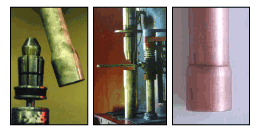
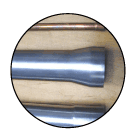
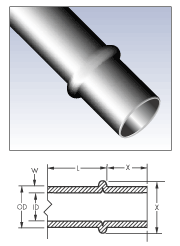
Rotary Beading - is a versatile form of end forming that can be used in a variety of industrial applications. For example, beaded joints can be used for O-rings or they can be used to connect hoses to a tube ends. In addition a beaded end can be used to interconnect exhaust tubes or low pressure fuel lines.
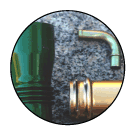
Beads can also be used to dampen vibration in solid lines or to increase the effectiveness of the seal when a rubber or fabric sleeve is clamped to a metal duct. Typical applications include low pressure air, exhaust, and liquid systems in automotive, appliance, and boating industries. Rotary beads are formed following the specifications detailed in MS-33660.
Compression Beading - is used in different applications than a rotary bead and does not keep as tight of a tolerance. Compression beads typically act as a stop 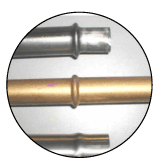 or as a means of containing another part within an area on the tube. This type of beading process is created by compressing two sides of the tube together by forcing the two tube ends towards one another. The trick is to leave a small gap open in-between a clamp that holds one end and a tube forming die that supports the other end. As the two tools hit their end point, the tube collapses at the gap creating the bead.
or as a means of containing another part within an area on the tube. This type of beading process is created by compressing two sides of the tube together by forcing the two tube ends towards one another. The trick is to leave a small gap open in-between a clamp that holds one end and a tube forming die that supports the other end. As the two tools hit their end point, the tube collapses at the gap creating the bead.
You can alter the width of the bead slightly by setting the distance of compression. Typical applications for this type of bead include, athletic equipment, lawn and garden, and personal sporting goods equipment.
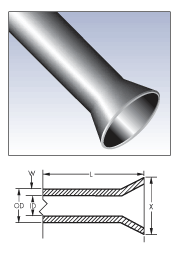
Single Flaring - the end of a tube is a process typically used to form a liquid tight, airtight connection at the end of a tube. There are two ways to accomplish a flared tube end. Rotary, or spinning the flared end, or ram forming. This fabrication method offers a long lasting seal that matches the exact shape of matching fittings such as J.I.C. nuts and sleeves. The single flare is available in both 37 degrees and 45 degrees and meets MIL spec #33584 and SAE specifications.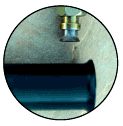
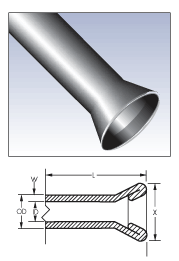
Double-Lap Flaring - offers additional strength for tube ends that are subjected to more stress and fatigue. The joint is designed so that the inside surface of the flare has a larger diameter so it does not interfere with flow characteristics of the system. Double lap flaring can be formed in the same shapes and meets the same specifications as the Single Flare.


"The Ultimate Goal... To help our customers create the lowest cost
possible without sacrificing quality, value or safety."
Corporate Office • 15333 N. Pima Road, Ste 305 Scottsdale, AZ 85260 • Tel 480.829.0450 • Fax 480.517.6929
Manufacturing Facility • 162 Jack Cooper Drive, Valley Head, AL 35989 • Tel 256.635.6700 • Fax 256.635.6710
© Copyright 2014 - Harco Metal Products, Inc.